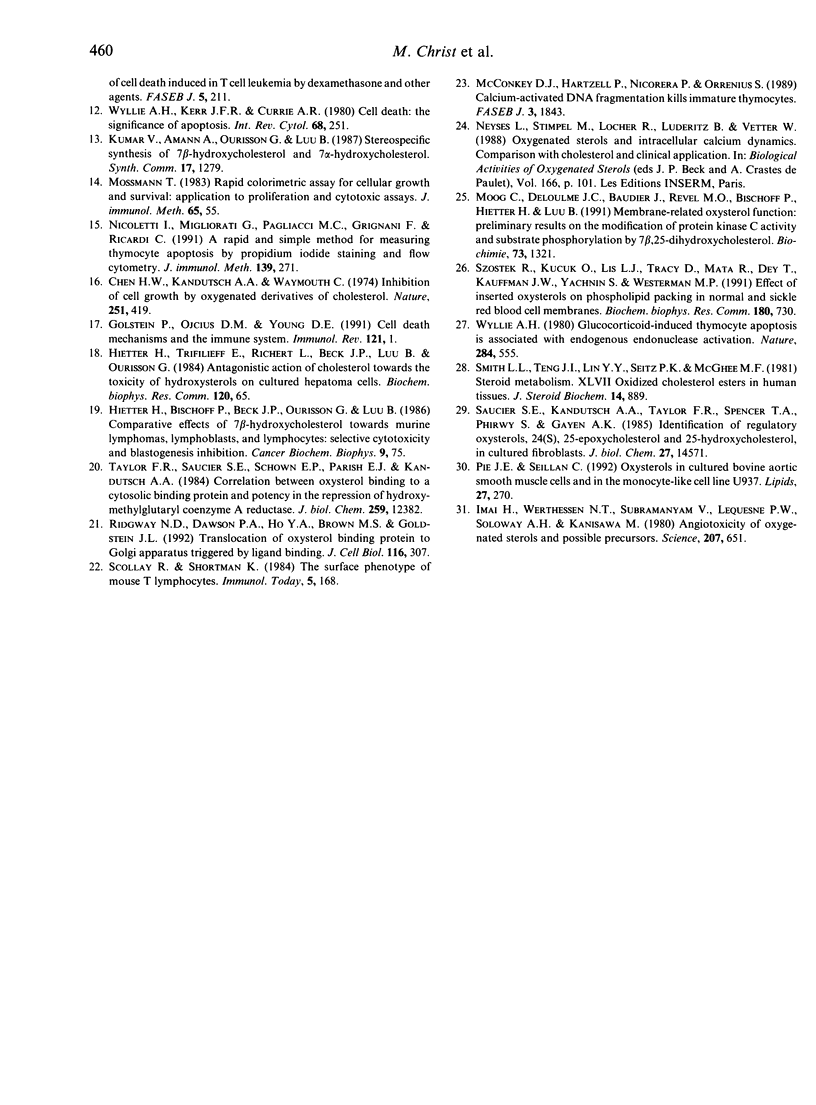Abstract
Oxygenated derivatives of cholesterol (oxysterols), a family of naturally occurring compounds, possess marked anti-proliferative and immunosuppressive activities, in particular they have been shown to inhibit T-cell responses to different stimuli. 25-Hydroxycholesterol (25-OHC) and 7 beta,25-dihydroxycholesterol (7.25-OHC) are able to kill not only RDM4 murine lymphoma in vitro, but also, surprisingly, mouse thymocytes after several hours of incubation. In this study, we report that the death of RDM4 and thymocytes induced by oxysterols exhibits the features of apoptosis. This phenomenon was identified by agarose gel electrophoresis of DNA fragments extracted from the cells and quantified by flow cytometric analysis of the DNA fluorescence of propidium iodide-stained cells. Cycloheximide and actinomycin D were found to decrease the number of apoptotic cells and to increase cell viability, indicating a requirement for the synthesis of macromolecules in oxysterol-induced programmed cell death. The pathway by which 25-OHC and 7.25-OHC are able to induce apoptosis in this type of cell and the possible contribution of these compounds to thymus involution during development are discussed.
Full text
PDF





Images in this article
Selected References
These references are in PubMed. This may not be the complete list of references from this article.
- Astruc M., Laporte M., Tabacik C., Crastes de Paulet A. Effect of oxygenated sterols on 3-hydroxy-3-methylglutaryl coenzyme A reductase and DNA synthesis in phytohemagglutinin-stimulated human lymphocytes. Biochem Biophys Res Commun. 1978 Nov 29;85(2):691–700. doi: 10.1016/0006-291x(78)91217-2. [DOI] [PubMed] [Google Scholar]
- Chen H. W., Kandutsch A. A., Waymouth C. Inhibition of cell growth by oxygenated derivatives of cholesterol. Nature. 1974 Oct 4;251(5474):419–421. doi: 10.1038/251419a0. [DOI] [PubMed] [Google Scholar]
- Christ M., Ji Y. H., Moog C., Pannecoucke X., Schmitt G., Bischoff P., Luu B. Antitumor activity of oxysterols. Effect of two water-soluble monophosphoric acid diesters of 7 beta-hydroxycholesterol on mastocytoma P815 in vivo. Anticancer Res. 1991 Jan-Feb;11(1):359–364. [PubMed] [Google Scholar]
- Hwang P. L. Biological activities of oxygenated sterols: physiological and pathological implications. Bioessays. 1991 Nov;13(11):583–589. doi: 10.1002/bies.950131108. [DOI] [PubMed] [Google Scholar]
- Imai H., Werthessen N. T., Subramanyam V., LeQuesne P. W., Soloway A. H., Kanisawa M. Angiotoxicity of oxygenated sterols and possible precursors. Science. 1980 Feb 8;207(4431):651–653. doi: 10.1126/science.7352277. [DOI] [PubMed] [Google Scholar]
- Luu B., Moog C. Oxysterols: biological activities and physicochemical studies. Biochimie. 1991 Oct;73(10):1317–1320. doi: 10.1016/0300-9084(91)90095-i. [DOI] [PubMed] [Google Scholar]
- McConkey D. J., Hartzell P., Nicotera P., Orrenius S. Calcium-activated DNA fragmentation kills immature thymocytes. FASEB J. 1989 May;3(7):1843–1849. doi: 10.1096/fasebj.3.7.2497041. [DOI] [PubMed] [Google Scholar]
- Moog C., Deloulme J. C., Baudier J., Revel M. O., Bischoff P., Hietter H., Luu B. Membrane-related oxysterol function: preliminary results on the modification of protein kinase C activity and substrate phosphorylation by 7 beta,25-dihydroxycholesterol. Biochimie. 1991 Oct;73(10):1321–1326. doi: 10.1016/0300-9084(91)90096-j. [DOI] [PubMed] [Google Scholar]
- Moog C., Luu B., Altmeyer A., Bischoff P. Studies on the immunosuppressive properties of 7,25 dihydroxycholesterol--II. Effects on early steps of T-cell activation. Int J Immunopharmacol. 1989;11(5):559–565. doi: 10.1016/0192-0561(89)90186-0. [DOI] [PubMed] [Google Scholar]
- Nicoletti I., Migliorati G., Pagliacci M. C., Grignani F., Riccardi C. A rapid and simple method for measuring thymocyte apoptosis by propidium iodide staining and flow cytometry. J Immunol Methods. 1991 Jun 3;139(2):271–279. doi: 10.1016/0022-1759(91)90198-o. [DOI] [PubMed] [Google Scholar]
- Parish E. J., Nanduri V. B., Kohl H. H., Taylor F. R. Oxysterols: chemical synthesis, biosynthesis and biological activities. Lipids. 1986 Jan;21(1):27–30. doi: 10.1007/BF02534299. [DOI] [PubMed] [Google Scholar]
- Pie J. E., Seillan C. Oxysterols in cultured bovine aortic smooth muscle cells and in the monocyte-like cell line U937. Lipids. 1992 Apr;27(4):270–274. doi: 10.1007/BF02536474. [DOI] [PubMed] [Google Scholar]
- Ridgway N. D., Dawson P. A., Ho Y. K., Brown M. S., Goldstein J. L. Translocation of oxysterol binding protein to Golgi apparatus triggered by ligand binding. J Cell Biol. 1992 Jan;116(2):307–319. doi: 10.1083/jcb.116.2.307. [DOI] [PMC free article] [PubMed] [Google Scholar]
- Saucier S. E., Kandutsch A. A., Taylor F. R., Spencer T. A., Phirwa S., Gayen A. K. Identification of regulatory oxysterols, 24(S),25-epoxycholesterol and 25-hydroxycholesterol, in cultured fibroblasts. J Biol Chem. 1985 Nov 25;260(27):14571–14579. [PubMed] [Google Scholar]
- Smith L. L., Teng J. I., Lin Y. Y., Seitz P. K., McGehee M. F. Sterol metabolism--XLVII. Oxidized cholesterol esters in human tissues. J Steroid Biochem. 1981 Sep;14(9):889–900. doi: 10.1016/0022-4731(81)90238-7. [DOI] [PubMed] [Google Scholar]
- Spangrude G. J., Sherris D., Daynes R. A. Inhibitory effects of various oxygenated sterols on the differentiation and function of tumor-specific cytotoxic T lymphocytes. Transplantation. 1982 May;33(5):482–491. doi: 10.1097/00007890-198205000-00005. [DOI] [PubMed] [Google Scholar]
- Szostek R., Kucuk O., Lis L. J., Tracy D., Mata R., Dey T., Kauffman J. W., Yachnin S., Westerman M. P. Effect of inserted oxysterols on phospholipid packing in normal and sickle red blood cell membranes. Biochem Biophys Res Commun. 1991 Oct 31;180(2):730–734. doi: 10.1016/s0006-291x(05)81126-x. [DOI] [PubMed] [Google Scholar]
- Taylor F. R., Saucier S. E., Shown E. P., Parish E. J., Kandutsch A. A. Correlation between oxysterol binding to a cytosolic binding protein and potency in the repression of hydroxymethylglutaryl coenzyme A reductase. J Biol Chem. 1984 Oct 25;259(20):12382–12387. [PubMed] [Google Scholar]
- Wyllie A. H. Glucocorticoid-induced thymocyte apoptosis is associated with endogenous endonuclease activation. Nature. 1980 Apr 10;284(5756):555–556. doi: 10.1038/284555a0. [DOI] [PubMed] [Google Scholar]
- Wyllie A. H., Kerr J. F., Currie A. R. Cell death: the significance of apoptosis. Int Rev Cytol. 1980;68:251–306. doi: 10.1016/s0074-7696(08)62312-8. [DOI] [PubMed] [Google Scholar]




